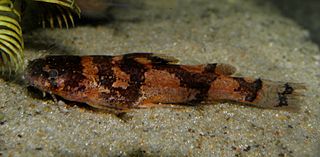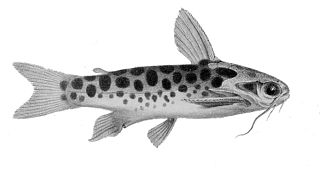
Hypostomus is a genus of catfish in the family Loricariidae. They are native to tropical and subtropical South America. H. plecostomus is the popular freshwater aquarium fish formerly known as Plecostomus plecostomus. The taxonomic structure of the Loricariidae is still being expanded by scientists. Hypostomus is a highly species-rich and widely distributed catfish genus.

The Pimelodidae, commonly known as the long-whiskered catfishes, are a family of catfishes.

Aspidoras is a genus of catfishes of the family Callichthyidae from Brazil.

Rineloricaria is a genus of freshwater tropical catfish belonging to the family Loricariidae. They are commonly called whiptail catfish because of the long filament that grows out of the tip of the caudal fin that is characteristic of the genus. With the exception of R. altipinnis from Panama, they are native to the rivers of northern and central South America. Some species are regularly seen in the aquarium trade.

Microglanis is a genus of fish in the family Pseudopimelodidae native to South America. This genus has the widest distribution within its family, with species ranging from the Guianas to Venezuela; western slope of the Andes in Ecuador and Peru to the Río de La Plata basin in Argentina. They occur eastward to the Orinoco and Amazon basins. It is also present in the eastern coastal rivers of Brazil.
Microglanis leptostriatus is a species of catfish belonging to the family Pseudopimelodidae. It appears to be entirely restricted to the middle and upper basin of the São Francisco River in Brazil.
Cephalosilurus is a small genus of catfishes of the family Pseudopimelodidae. The genus was first described in 1911.

The Hypoptopomatinae are a subfamily of catfishes of the family Loricariidae, composed of 17 genera and approximately 80 species. This subfamily represents about one-tenth of all loricariid species.

Pimelodus is a genus of fish in the family Pimelodidae native to Central and South America.
Pareiorhaphis is a genus of catfish in the family Loricariidae native to South America. This genus can be readily distinguished from other neoplecostomines by the unique combination of having fleshy lobes on lateral margins of head ornamented with hypertrophied odontodes on nuptial males, caudal peduncle ovoid in cross section, abdomen usually naked, dorsal fin spinelet ovoid and adipose fin usually present. The color pattern is usually dark brown and mottled with the abdomen white. Most species in to Pareiorhaphis were originally described in Hemipsilichthys. In 1918, Alípio de Miranda-Ribeiro proposed the new genus Pareiorhaphis. Whether Pareiorhaphis is monophyletic or not is currently unknown.
Isbrueckerichthys is a genus of armored catfishes which are endemic to Brazil.
Corumbataia is a genus of armored catfishes native to South America where they are only known from Brazil.
Pseudotocinclus is a genus of armored catfishes native to South America.

Pseudacanthicus is a genus of medium to large-sized suckermouth armored catfishes native to South America, where found in the Amazon and Orinoco basins, as well as rivers of the Guianas. They are primarily found in fast-flowing waters, sometimes relatively deep. They are sometimes kept in aquariums.
Pseudolithoxus is a genus of suckermouth armored catfishes with five described species from the basins of the Orinoco, Casiquiare and upper Rio Negro in Venezuela. Additionally, a possibly undescribed species is known from the Trombetas and Nhamundá rivers in Brazil.
Cetopsis is a genus of catfishes of the family Cetopsidae.

Tatia is a genus of small South American catfishes belonging to Auchenipteridae, the driftwood catfish family.
Gelanoglanis is a genus of fish in the family Auchenipteridae native to South America.

Cetopsis candiru, also known as candiru, candiru açú, candiru cobra or canero, is a carnivorous species of whale catfish found in the Amazon basin of Peru, Brazil and Bolivia. Similar to Cetopsis coecutiens, Cetopsis candiru is a large species of the genus Cetopsis and a widespread scavenger, known for its voracious feeding and the habit of burrowing into the carcasses of dead animals and humans. Despite its name, it is not closely related to the bloodsucking Candiru.

Astyanax argyrimarginatus is a small species of freshwater fish native to various river basins in Brazil. Originally thought to be restricted to the Tocantins-Araguaia river system, a study in 2012 expanded its range to include the Rio Xingu, as well. Specific biotope preferences are unknown, but it is mostly collected from clearwater streams in fairly good health. Its relative abundance and presence in some protected locales means that it is not endangered.










